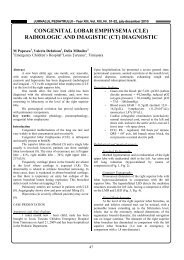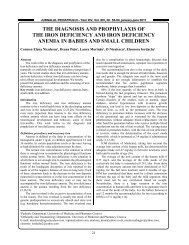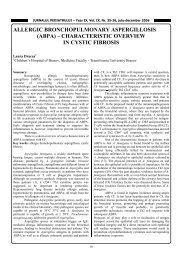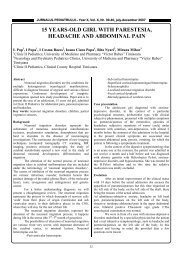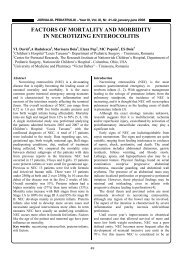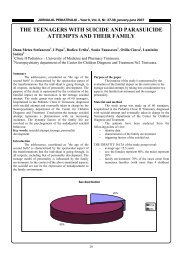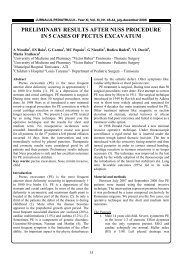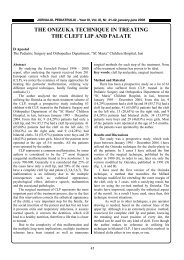address editor in chief co-editors secretary editorial board
address editor in chief co-editors secretary editorial board
address editor in chief co-editors secretary editorial board
Create successful ePaper yourself
Turn your PDF publications into a flip-book with our unique Google optimized e-Paper software.
JURNALUL PEDIATRULUI – Year XV, X<br />
, Vol. XV, Nr. 59-60<br />
60, , july<br />
j<br />
uly-december 2012<br />
LAPAROSCOPIC APPROACH IN RECTO-COLIC<br />
DISEASES IN CHILDREN<br />
M Oancea 1,2 , Lorena Vatra 2 , Anna Kadar 2<br />
Abstract<br />
Objectives: This paper is <strong>in</strong>tended to analyze the<br />
cl<strong>in</strong>ical applicability and efficiency of the laparos<strong>co</strong>pic<br />
recto-sigmoidian resection <strong>in</strong> children suffer<strong>in</strong>g from<br />
<strong>co</strong>ngenital mega<strong>co</strong>lon and chronic idiopathic <strong>co</strong>nstipation.<br />
Material and method: Between April 2001 - June 2012<br />
were operated on 49 children diagnosed with <strong>co</strong>ngenital<br />
mega<strong>co</strong>lon or medically <strong>in</strong>tractable chronic <strong>co</strong>nstipation.<br />
We excluded from the analysis 7 children operated on<br />
ac<strong>co</strong>rd<strong>in</strong>g to the Duhamel procedure, 6 cases <strong>in</strong> which the<br />
<strong>in</strong>tervention was performed <strong>in</strong> a transanal (TERPT) manner,<br />
a newborn with a total aganglionic form who died shortly<br />
after ileostomy and two cases who were out of the re<strong>co</strong>rds<br />
after <strong>co</strong>lostomy. A laparos<strong>co</strong>pic rectosigmoidian resection<br />
was practiced <strong>in</strong> 31 cases, with a mean age of 3.8 years (6<br />
weeks-17 years), and <strong>in</strong> two cases the <strong>in</strong>tervention was<br />
limited to multiple <strong>in</strong>test<strong>in</strong>al biopsy. Recto-<strong>co</strong>lic<br />
laparos<strong>co</strong>pic biopsy was performed <strong>in</strong> 20 patients: 5 times<br />
before surgery, 8 times when practic<strong>in</strong>g <strong>co</strong>lostomy and <strong>in</strong> 7<br />
cases dur<strong>in</strong>g def<strong>in</strong>itive surgery. In the rema<strong>in</strong><strong>in</strong>g patients the<br />
resection was assessed by changes <strong>in</strong> the <strong>co</strong>lic wall<br />
appearance; histological exam<strong>in</strong>ation were practiced on the<br />
fragments of the specimen. In 8 cases the f<strong>in</strong>al operation<br />
was preceded by temporary <strong>co</strong>lostomy practice and <strong>in</strong> a<br />
s<strong>in</strong>gle case by an ileostomy. Preoperative preparation of the<br />
<strong>co</strong>lon was made after a variable schedule depend<strong>in</strong>g on the<br />
age of the patient and volume of the fecal retention. The<br />
standard approach- rectosigmoid resection is performed with<br />
optic trocar <strong>in</strong> the right upper quadrant and with two<br />
pararectal work<strong>in</strong>g trocars placed on the right and on the<br />
left. Oral nutrition was allowed from the first postoperative<br />
day, depend<strong>in</strong>g on re<strong>co</strong>very of the bowel movement.<br />
Patients were discharged on average, 9 days after surgery.<br />
Results: There were no significant differences <strong>in</strong><br />
postoperative out<strong>co</strong>me between children operated on for<br />
<strong>co</strong>ngenital mega<strong>co</strong>lon ( 21 patients) and those for severe<br />
<strong>co</strong>nstipation (10 patients). Intest<strong>in</strong>al transit re<strong>co</strong>very was<br />
noted immediately, <strong>in</strong> day I-III, but, <strong>in</strong> some cases, followed<br />
by variable periods of bowel movement disorders requir<strong>in</strong>g<br />
treatment. Patients were discharged, on average, 9 days<br />
after surgery. Soil<strong>in</strong>g persisted <strong>in</strong> 4 of the patients at the<br />
time of analysis. In one of the patients redo surgery was<br />
required because of <strong>in</strong>adequate resection of the aganglionic<br />
segment. We re<strong>co</strong>rded two cases of anastomotic fistula<br />
resolved by temporary <strong>co</strong>lostomy. One of the patients<br />
developed an anastomotic stenosis. In this series we<br />
registered no deaths.<br />
Conclusions: Laparos<strong>co</strong>pic approach allowed<br />
personalized diagnostic strategy and improved surgical<br />
therapy results <strong>in</strong> <strong>co</strong>lic motility disorders <strong>in</strong> children.<br />
Key words: <strong>co</strong>ngenital mega<strong>co</strong>lon, chronic <strong>co</strong>nstipation,<br />
laparos<strong>co</strong>py.<br />
Introduction<br />
Aganglionic <strong>co</strong>lorectal resection and restoration of<br />
digestive <strong>co</strong>nt<strong>in</strong>uity with preservation of functional anal<br />
sph<strong>in</strong>cter structures was felt that the logical treatment of<br />
mega<strong>co</strong>lon and applied <strong>in</strong> the cl<strong>in</strong>ic for the first time by<br />
Orvar Swenson <strong>in</strong> 1948 (1). The analysis of Swenson<br />
operation results allowed the identification of <strong>co</strong>mplications<br />
and unsatisfactory results that were directly related to the<br />
surgical approach- low rectal resection with <strong>co</strong>loanal<br />
anastomosis performed by <strong>co</strong>mb<strong>in</strong>ed abdom<strong>in</strong>o-per<strong>in</strong>eal<br />
approach. Try<strong>in</strong>g to <strong>co</strong>rrect the Swenson operation,<br />
B.Duhamel proposed <strong>in</strong> 1956, an operation <strong>in</strong> which, after<br />
bowel resection, aganglionic rectum is preserved under the<br />
promontory (2), and <strong>in</strong> 1964 F.Soave proposed rectal<br />
mu<strong>co</strong>sectomy, keep<strong>in</strong>g rectal muscle sheath and pull<br />
through of the normal bowel with<strong>in</strong> it (3). Accumulat<strong>in</strong>g<br />
significant number of patients, operated through these<br />
methods, showed that keep<strong>in</strong>g the rectum be<strong>co</strong>mes a source<br />
of limit<strong>in</strong>g quality therapeutic results. In 1995 K.Georgeson<br />
(4) enters <strong>in</strong>to practice rectosigmoidian resection and<br />
abdom<strong>in</strong>o-per<strong>in</strong>eal pull-through <strong>in</strong> one stage performed by<br />
laparos<strong>co</strong>py.<br />
The purpose of this paper is to present the <strong>in</strong>itial series of<br />
patients operated on laparos<strong>co</strong>pic and to evaluate the safety<br />
and effectiveness of the method.<br />
Material and method<br />
From April 2001 to June 2012 were treated 49 children<br />
affected by severe forms of <strong>co</strong>lic motility disorders, diseases<br />
occurr<strong>in</strong>g outside a general, endocr<strong>in</strong>e or lumbo-sacral<br />
sp<strong>in</strong>al <strong>in</strong>juries. We use both <strong>co</strong>ntrast enema(fig.1, fig.2) and<br />
histopathologic exam to diagnose <strong>co</strong>ngenital mega<strong>co</strong>lon or<br />
idiopathic <strong>co</strong>nstipation. Patients diagnosed with idiopathic<br />
<strong>co</strong>nstipation were operated on only after failure of medical<br />
therapy and bowel management program.<br />
1 University of Medic<strong>in</strong>e and Pharmacy “Victor Babes” Timisoara – phD student<br />
2 “M.S.Curie” Emergency Hospital for Children Bucharest – Pediatric Surgery Department<br />
E-mail: mar_oancea@yahoo.<strong>co</strong>m, lorena.vatra@rodelta.ro, kadar_anna@hotmail.<strong>co</strong>m<br />
50



